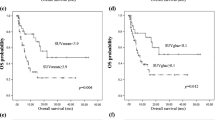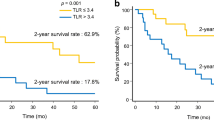Abstract
Surgical resection is the only curative treatment strategy for intrahepatic cholangiocarcinoma (CC). Therefore, accurate staging is essential for appropriate management of patients with CC. We assessed the usefulness of 2-[18F]fluoro-2-deoxy-d-glucose (FDG) positron emission tomography (PET) in the staging of CC. We undertook a retrospective review of FDG PET images in 21 patients (10 female, 11 male; mean age 57 years) diagnosed with CC. Ten patients had hilar CC and 11, peripheral CC. Patients underwent abdominal magnetic resonance imaging (MRI) (n=20) and computed tomography (CT) (n=12) for the evaluation of primary tumours, and chest radiography and whole-body bone scintigraphy for work-up of distant metastases. For semi-quantitative analysis, the maximum voxel standardised uptake value (SUVmax) was obtained from the primary tumour. All peripheral CCs showed intensely increased FDG uptake, and some demonstrated ring-shaped uptake corresponding to peripheral rim enhancement on CT and/or MRI. In nine of the ten patients, hilar CCs demonstrated increased FDG uptake of a focal nodular or linear branching appearance. The remaining case was false negative on FDG PET. One patient with a false negative result on MRI demonstrated increased uptake on FDG PET. Among the ten hilar CCs, FDG uptake was intense in only two patients and was slightly higher than that of the hepatic parenchyma in the remaining patients. For the detection of lymph node metastasis, FDG PET and CT/MRI were concordant in 16 patients, and discordant in five (FDG PET was positive in three, and CT and MRI in two). FDG PET identified unsuspected distant metastases in four of the 21 patients; all of these patients had peripheral CC. FDG PET is useful in detecting the primary lesion in both hilar and peripheral CC and is of value in discovering unsuspected distant metastases in patients with peripheral CC. FDG PET could be useful in cases of suspected hilar CC with non-confirmatory biopsy and radiological findings.







Similar content being viewed by others
References
Ros PR, Buck JL, Goodman ZD, Ros AMV, Olmsted WW. Intrahepatic cholangiocarcinoma: radiologic-pathologic correlation. Radiology 1988; 176:689–693.
Edmonson HA, Craig JR. Peripheral cholangiocarcinoma. In: Schiff L, Schiff ER, eds. Disease of the liver. Philadelphia: J.B. Lippincott; 1984:1130–1136.
Kawarada Y, Mizumoto R. Diagnosis and treatment of cholangiocellular carcinoma of the liver. Hepatogastroenterology 1990; 37:176–181.
Schlinkert RT, Nagorney DM, van Heerden JA, Adson MA. Intrahepatic cholangiocarcinoma; clinical aspects, pathology and treatment. HPB Surg 1992; 5:95–101.
Haug CE, Jenkins RL, Rohrer RJ, Auchincloss H, Delmonico FL, Freeman RB, Lewis WD, Cosimi AB. Liver transplantation for primary hepatic cancer. Transplantation 1992; 53:376.
Hoh CK, Hawkins RA, Glaspy JA, Dahlbom M, Tse NY, Hoffman EJ, Schiepers C, Choi Y, Rege S, Nitzsche E. Cancer detection with whole-body PET using 2-[18F] fluoro-2-deoxy-d-glucose. J Comput Assist Tomogr 1993; 17:582–589.
Keiding S, Hansen SB, Rasmussen HH, Gee A, Kruse A, Roelsgaard K, Tage-Jensen U, Dahlerup JF. Detection of cholangiocarcinoma in primary sclerosing cholangitis by positron emission tomography. Hepatology 1998; 28:700–706.
Widjaja A, Mix H, Wagner S, Graz KF, van den Hoff J, Petrich T, Meier PN, Manns MP. Positron emission tomography and cholangiocarcinoma in primary sclerosing cholangitis. Z Gastroenterol 1999; 37:731–733.
Okazumi S, Isono K, Enomoto K, Kikuchi T, Ozaki M, Yamamoto H, Hayashi H, Asano T, Ryu M. Evaluation of liver tumors using fluorine-18-fluorodeoxyglucose PET: characterization of tumor and assessment of effect of treatment. J Nucl Med 1992; 33:333–339.
Fritscher-Ravens A, Bohuslavizki KH, Broering DC, Jenicke L, Schafer H, Buchert R, Rogiers X, Clausen M. FDG PET in the diagnosis of hilar cholangiocarcinoma. Nucl Med Commun 2001; 22:1277–1285.
Kluge R, Schmidt F, Caca K, Barthel H, Hesse S, Georgi P, Seese A, Huster D, Berr F. Positron emission tomography with [18F]fluoro-2-deoxy-d-glucose for diagnosis and staging of bile duct cancer. Hepatology 2001; 33:1029–1035.
Kato T, Tsukamoto E, Kuge Y, Katoh C, Nambu T, Nobuta A, Kondo S, Asaka M, Tamaki N. Clinical role of18F-FDG PET for initial staging of patients with extrahepatic bile duct cancer. Eur J Nucl Med Mol Imaging 2002; 29:1047–1054.
Okuda K, Kubo Y, Okazaki N, Arishima T, Hashimoto M. Clinical aspects of intrahepatic bile dut carcinoma including hilar carcinoma: a study of 57 autopsy proven cases. Cancer 1977; 39:232–246.
Soyer P, Bluemke DA, Reichle R, Calhoun PS, Bliss DF, Scherrer A, Fishman EK. Imaging of intrahepatic cholangiocarcinoma. 1. Peripheral cholangiocarcinoma. AJR 1995; 165:1427–1431.
Nakeeb A, Pitt HA, Sohn TA, Coleman J, Abrams RA, Piantadosi S, Hruban RH, Lillemoe KD, Yeo CJ, Cameron JL. Cholangiocarcinoma. A spectrum of intrahepatic, perihilar, and distal tumors. Ann Surg 1996; 224:463–475.
Worawattanakul S, Semelka R, Noone TC, Calvo BF, Kelekis NL, Woosley JT. Cholangiocarcinoma: spectrum of appearance on MR images using current techniques. Magn Reson Imaging 1998; 16:993–1003.
Shreve PD, Anzai Y, Wahl RL. Pitfalls in oncologic diagnosis with FDG PET imaging: physiologic and benign variants. Radiographics 1999; 19:61–77.
Hamrick-Turner J, Abbitt PL, Ros PR. Intrahepatic cholangiocarcinoma: MR appearance. AJR 1992; 158:77–79.
Schoefl R, Haefner M, Wrba F, Pfeffel F, Stain C, Poetzi R, Gangl A. Forceps biopsy and brush cytology during endoscopic retrograde cholangiopancreatography for the diagnosis of biliary stenosis. Scand J Gastroenterol 1997; 32:363–368.
Glasbrenner B, Ardan M, Boeck W, Preclik G, Moller P, Adler G. Prospective evaluation of brush cytology of biliary strictures during ERCP. Endoscopy 1999; 31:712–717.
Feydy A, Vilgrain V, Denys A, Sibert A, Belghiti J, Vullierme MP, Menu Y. Helical CT assessment in hilar cholangiocarcinoma: correlation with surgical and pathologic findings. AJR 1999; 172:73–77.
NakajimaT, Kondo Y, Miyazaki M, Okui K. A histopathologic study of 102 cases of intrahepatic cholangiocarcinoma: histologic classification and modes of spreading. Hum Pathol 1988; 19:1228–1234.
Author information
Authors and Affiliations
Corresponding author
Rights and permissions
About this article
Cite this article
Kim, YJ., Yun, M., Lee, W.J. et al. Usefulness of 18F-FDG PET in intrahepatic cholangiocarcinoma. Eur J Nucl Med Mol Imaging 30, 1467–1472 (2003). https://doi.org/10.1007/s00259-003-1297-8
Received:
Accepted:
Published:
Issue Date:
DOI: https://doi.org/10.1007/s00259-003-1297-8




